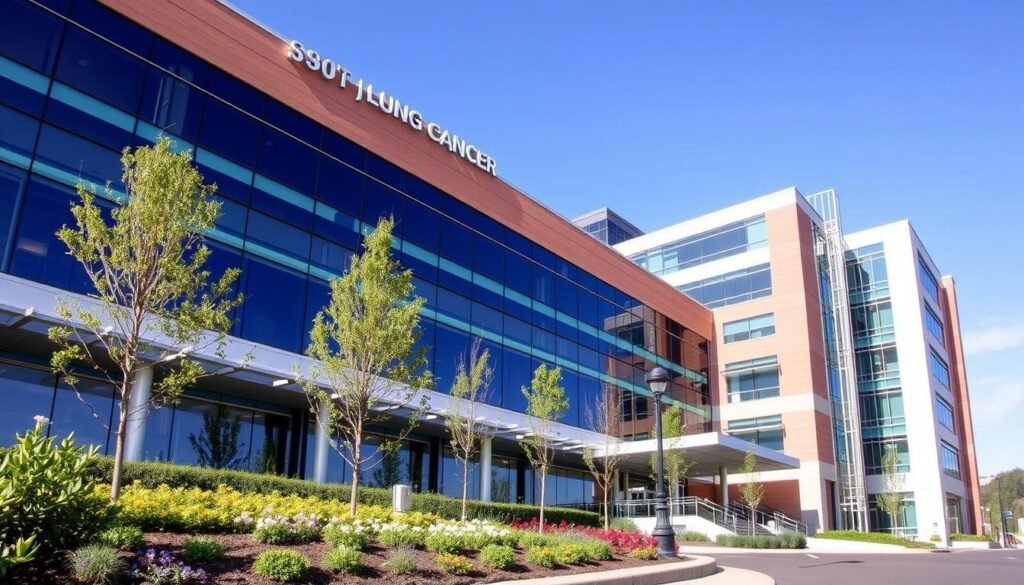Asbestos exposure causes about 4% of lung cancer cases in the US. This results in more than 9,000 people getting sick every year. Lung cancer is a top killer among all cancers. So, knowing where to get treatment matters a lot.
The best hospitals, such as Mayo Clinic, see many patients. This experience leads to better results. This article looks at the best places for lung care. They offer new treatments, have great doctors, and really care about their patients.
Key Takeaways
- The average lung cancer diagnosis occurs at around 70 years old.
- Mayo Clinic sees over 6,000 lung cancer patients annually, boasting a robust team of cancer specialists.
- Hospitals like University of Colorado Denver Hospital exhibit a 15.5% higher five-year survival rate than the national average.
- UCLA Medical Center ranks among the top five in the nation for pulmonology and has a long-standing reputation for excellence.
- Cleveland Clinic offers extensive lung cancer resources and a dedicated treatment hub in Florida.
- High-volume treatment centers generally achieve better surgical outcomes for lung cancer patients.
- Access to clinical trials is a significant advantage provided by leading lung cancer treatment centers like Mayo Clinic.
Understanding Lung Cancer and Its Treatment
Lung cancer is a major health issue, with 9,000 new US cases each year. Smoking, asbestos, and genetics are key factors. Knowing these can help in prevention and early detection. It’s crucial to be aware of symptoms and risks to keep your health in check.
Prevalence and Causes of Lung Cancer
Lung cancer is a top cause of cancer deaths worldwide. It’s important to know the main causes to lower risks. Smoking is a major cause, leading to anti-smoking campaigns. Asbestos and genetics also increase the risk, highlighting the importance of screening for those at risk.
Advancements in Lung Cancer Treatments
Treatment for lung cancer is improving fast, offering hope to patients. There are many options, from surgery to remove tumors to targeted therapy. Targeted therapy fights gene mutations in tumors. Recent advances include immunotherapy and precise radiation, leading to more personalized treatments. This means better results with fewer side effects.
Importance of Choosing the Right Hospital
Finding the right hospital for lung cancer treatment is crucial. Specialized hospitals achieve better results thanks to their expertise. They offer the latest treatments and focus on the patient. Choosing a hospital wisely can greatly affect your recovery path.
Best Hospitals for Lung Cancer Treatment
Finding the best hospital for lung cancer treatment is crucial. There are many top-rated programs in the United States. They are known for their high expertise and innovative care. Here are some of the top hospitals for lung cancer.
Mayo Clinic – Renowned Lung Cancer Department
The Mayo Clinic is known for its top care in lung cancer. It uses a team approach for a wide range of lung cancers. They focus on personalized treatment for each patient. The clinic treats over 6,000 lung cancer patients every year. This shows their deep experience.
University of Colorado Denver Hospital
The University of Colorado Denver Hospital stands out for its lung cancer survival rates. It focuses on cutting-edge research and clinical trials. Patients get the latest treatments and a lot of support.
UCLA Medical Center – California Lung Treatment
UCLA Medical Center is a leader in lung care. It has a great team using new technologies and treatments. Its research efforts make it a top lung cancer hospital.
Cedars-Sinai Medical Center – California Lung Care
Cedars-Sinai has a strong focus on research and new treatments. It provides full care for lung cancer patients. They get the best therapies and support through their treatment.
Cleveland Clinic – Ohio Premier Cancer Center
The Cleveland Clinic is among the leading lung cancer centers. It’s known for its tech advancements and treatment options. The clinic’s reputation is built on excellent patient care and research.
Criteria for Ranking the Top Lung Cancer Hospitals
Choosing the right hospital for lung cancer treatment is a big decision. It includes looking at the quality of patient experience, specialized care, and how well staff communicate. The best hospitals make patients feel important and listened to.
Patient Experience and Care Quality
The way patients feel at a hospital greatly impacts its ranking. When healthcare workers and patients get along well, satisfaction goes up. Also, hospitals with teams of experts like medical oncologists, pulmonologists, and surgeons offer better, personalized care. Those looking for thorough care should pick hospitals known for supporting patients well, including in areas like palliative care and diet advice.
Accreditations and Designations
Having the right accreditations affects how people view a cancer hospital. Groups like the National Cancer Institute and the American College of Surgeons check if hospitals meet tough standards. There are 72 NCI-designated cancer centers in 35 states and D.C., all known for high-quality care. Being recognized by the Commission on Cancer means a hospital follows top treatment plans.
Research and Innovation in Treatments
Innovation is key in ranking lung cancer hospitals. Hospitals leading in research give patients new treatment options through clinical trials, improving chances of survival. Those tied to the NCI’s Cancer Center Programs stand out for their research, offering the newest therapies. A focus on new treatments shows a hospital’s commitment to better care and oncology advancements.
Specialized Lung Cancer Departments in Leading Hospitals
Expert lung cancer departments are essential for giving patients advanced treatments. They cater to individual needs. Many top cancer programs in the U.S. have set up specialized lung cancer hospitals. These focus on all-around care and new treatment ways.
Mayo Clinic’s Comprehensive Cancer Center
The Mayo Clinic stands out in lung cancer care with its cutting-edge diagnostics and treatments. Research is quickly used in patient care, improving outcomes. With advanced imaging and personalized care plans, they achieve great results. This makes them a leader in lung cancer hospitals.
UCHealth’s Innovative Cancer Programs
UCHealth focuses on personalized care during the entire treatment process. Teams work together to offer support, including lung rehab and counseling. They ensure complete care. Their model gives easy access to added services, leading in lung cancer care.
UCLA’s Specialized Program of Research Excellence (SPORE)
UCLA’s SPORE is known for its focus on molecular profiling. This guides precise treatments for patients. By looking at individual molecular details, they make targeted therapy plans. This personal medicine approach boosts treatment success. UCLA is among the top lung cancer centers.

| Hospital | Key Focus | Special Services |
|---|---|---|
| Mayo Clinic Comprehensive Cancer Center | Innovative diagnostics and treatments | Advanced imaging, personalized care plans |
| UCHealth | Personalized cancer programs | Lung rehabilitation, psychological counseling |
| UCLA SPORE | Molecular profiling for lung cancer | Targeted therapies based on individual profiles |
These departments show a strong commitment to advancing care with new methods and personalized treatments. Patients will find top programs offering unique support and comprehensive treatments.
For more info on lung cancer care, visit Cleveland Clinic’s expert lung cancer departments.
Cutting-edge Technologies Used in Lung Cancer Treatment
Medicine is rapidly advancing in the fight against lung cancer. Cutting-edge technologies focus on making diagnoses more accurate. They also improve surgical outcomes, leading to better care for patients. As treatments get better, advanced imaging and less invasive surgeries become more crucial.
Advanced Imaging Techniques
Advanced imaging is critical for accurate cancer diagnosis and tracking. Positron Emission Tomography (PET) and Computed Tomography (CT) scans offer deep insights into tumors. This helps doctors create treatment plans tailored to each patient’s needs.
Minimally Invasive Surgical Procedures
Minimally invasive surgery, like robotic lobectomy, is becoming a popular option. This surgery leads to:
- Reduced recovery times
- Lower risk of complications
- A quicker return to normal life
Robotic surgery means fewer post-operative issues for many patients. Most can go home within 3-5 days after surgery. This shows a shift towards care that focuses more on the patient.
| Technology | Description | Patient Benefits |
|---|---|---|
| Advanced Imaging Techniques | Utilizes technologies like PET and CT for precise diagnostics | Better treatment personalization and monitoring |
| Minimally Invasive Surgery | Includes procedures like robotic lobectomy | Shorter recovery times and fewer complications |
These advances not only improve care quality but also focus on better patient outcomes in lung cancer treatment. Ongoing research and new technologies promise a brighter future for those facing this disease.
Clinical Trials and Research Opportunities
Clinical trials are key in advancing lung cancer treatment. The importance of clinical research is huge, offering patients new therapy options not found in standard care. Many top hospitals are conducting lung cancer trials. They offer patients exciting research opportunities for lung cancer. These can improve patient outcomes and lead to breakthrough treatments.
Importance of Clinical Trials for Patients
Joining clinical trials gives patients access to the latest therapies. These trials test new drugs and methods for safety and effectiveness. Being part of a clinical trial can connect patients to the newest advancements in cancer care.
Notable Clinical Trials at Top Hospitals
Leading institutions are making big steps in lung cancer research. They’re exploring new treatments and drug combinations. Here are some key studies:
| Trial Name | Objective | Facility |
|---|---|---|
| BI 1015550 | Evaluate efficacy and safety in PF-ILDs | Mayo Clinic |
| ADXS-503 with Pembro | Assess safety and tolerability in NSCLC | UCLA Health |
| Ociperlimab vs. Pembrolizumab | Compare treatment outcomes | UCLA Health |
| Relatlimab plus Nivolumab | Assess safety and progression-free survival | NYU Langone Health |
| AERIFY 3 | Evaluate action on airway inflammation | UCLA Health |
| ARISE and ENCORE | Assess treatments for MAC lung infection | NYU Langone Health |

Patient Support Services in Lung Cancer Facilities
Successful lung cancer treatment includes more than just advanced medical care. It also involves thorough patient support services. These services are key to better care. Cedars-Sinai is known for its wide range of support services. They pay attention to the mental and social sides of cancer care.
Psychosocial Support for Patients and Families
Getting diagnosed with lung cancer can be tough for patients and their families. Psychosocial care in cancer treatment helps by offering needed emotional support. Teams at top facilities aid patients in dealing with their emotions and staying strong. Inviting family into this support circle helps everyone feel connected.
Nutritional and Rehabilitation Services
Eating right is crucial during lung cancer treatment. Nutritional support for lung cancer helps patients get the nutrients they need to keep up their strength. This includes custom meal plans and advice on nutrition. Rehabilitation boosts healing with physical therapy and exercises tailored for lung cancer patients.
| Support Service | Description | Benefits |
|---|---|---|
| Psychosocial Support | Counseling and support groups for emotional well-being | Helps in managing stress and anxiety |
| Nutritional Counseling | Personalized meal plans and nutrition advice | Maintains strength and promotes healing |
| Rehabilitation Services | Physical therapy and exercise programs | Improves mobility and overall health |
Having access to all-encompassing support services changes the quality of life for lung cancer patients. For instance, the care at Mount Sinai Center of Excellence for Thoracic shows how vital it is. They combine psychosocial and nutritional support with regular treatments.
The Impact of Hospital Volume on Patient Outcomes
Choosing where to get treated for lung cancer is crucial. Studies prove the impact of hospital volume in cancer treatment is big. Facilities with more cases often have better results. This part explores how high-volume hospitals excel in lung cancer care.
Experience Matters: High Volume vs. Low Volume Hospitals
More hospital cases mean better surgery outcomes. High volume lung cancer hospitals have a 25% higher 5-year survival rate. This isn’t just true for lung cancer. Other surgeries show similar trends. For example:
- High-volume places have fewer post-surgery deaths and complications.
- Patients at these centers also live longer.
- One study showed high-volume hospitals had fewer deaths from lung surgeries than low-volume ones.
Success Rates in Top Lung Cancer Centers
Lung cancer treatment success is linked to how many patients a hospital treats. A study of over 19,556 patients from 2005 to 2010 showed this. It looked at death rates 30 days after lung cancer surgery.
| Hospital Volume Category | 5-Year Survival Rate | 30-Day Mortality Rate |
|---|---|---|
| High Volume | 75% | 6.1% |
| Medium Volume | 65% | 9.5% |
| Low Volume | 50% | 12.9% |
Better results come from hospitals that do more procedures. High-volume places offer advanced technology and specialized teams. So, choosing a busy hospital can really help lung cancer patients live longer.
Insurance Coverage and Treatment Costs
Understanding insurance coverage is key for people with lung cancer. It helps ease the financial stress of treatment. Most Americans, about 55%, have health plans from their jobs. These plans usually help cover cancer treatment costs. The Health Insurance Marketplace offers plans too. They cover pre-existing conditions like cancer. Medicare is also important. It usually pays for 80% of outpatient cancer treatment. However, patients must pay the remaining 20% until they hit their yearly deductible.
Understanding Your Options with Insurance
The costs for lung cancer treatment can feel overwhelming. Each year, patients pay about $5.6 billion out-of-pocket for cancer care. In 2019, they spent $1.35 billion on treatments, including chemotherapy and surgery. Cancer care costs are increasing. They’re expected to go from $190.2 billion in 2015 to $246.6 billion by 2030. Knowing your insurance policy is crucial. There are ways to manage these costs, like:
- Working with financial counselors
- Reviewing insurance plan documents
- Exploring life insurance policy options
- Seeking financial assistance programs
- Setting up payment plans with providers
- Applying for Social Security benefits
Potential Financial Assistance and Resources
Travel for treatment can add to costs. The National Cancer Institute (NCI) says initial lung cancer care averages $68,293. Continuing care is about $12,389, but costs soar at end-of-life. But there’s help. Organizations like the Patient Access Network Foundation (PANF) and Patient Advocate Foundation (PAF) support under-insured patients. They help cover out-of-pocket costs.
Patient Testimonials and Success Stories
Personal stories from those battling lung cancer offer deep insights into their treatment journey. These stories show the high level of care at leading lung cancer hospitals. They help others facing similar battles make important treatment decisions. This section shines a light on patient testimonials and inspiring success stories from top cancer centers.
Real-Life Cases from Leading Hospitals
At Cancer Treatment Centers of America®, one patient talked about her fight with stage 1 lung cancer. A tumor was found during a check-up in 2014. Doctors suggested surgery to remove it. In October 2015, she had a minimally invasive operation to take out the upper right part of her lung. The surgery was a success, getting rid of the cancer without needing chemo or radiation. She was thankful and mentioned:
“The recovery was quicker than I expected, and I felt minimal pain. I’m even planning to run in the Chicago Marathon in 2018!”
Another story involves a patient dealing with lung cancer coming back after chemo. In June 2015, doctors suggested trying new treatments from clinical trials due to specific gene changes. This person did well on the trial medicine, with few side effects. They also started a Facebook group for Australians with lung cancer. This shows the big benefits of clinical trials and the support found in leading hospitals.
Patient Experiences at Top Treatment Centers
- Patient satisfaction is high thanks to teams offering organized and compassionate care.
- Yearly screenings help catch lung cancer early, making treatment more successful.
- Many choose less invasive surgery to avoid harsh treatments like chemotherapy and radiation.
- Stories highlight how comprehensive care greatly improves life during and after treatment.

Conclusion
Choosing the right hospital for lung cancer treatment is very important. The best lung cancer hospitals not only offer advanced treatments but also focus deeply on patient care, research, and innovation. With lung cancer survival rates rising to 28.4% over the past five years, the choice of a high-quality treatment center is vital.
It’s worrying that only 16.0% of people at high risk get screened for lung cancer. This could greatly reduce death rates. It shows we need to do more to teach people about the value of being proactive about their health. Patients are encouraged to use their resources to find the best hospitals for their needs.
Being well-informed about treatment options and the benefits of specialized care can greatly improve a person’s quality of life and recovery chances. There is a big need to keep pushing for early screening and treatment at top hospitals. This is key to getting better results in lung cancer care.